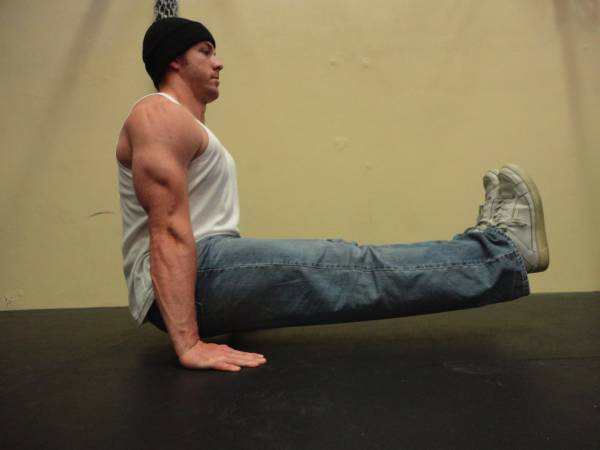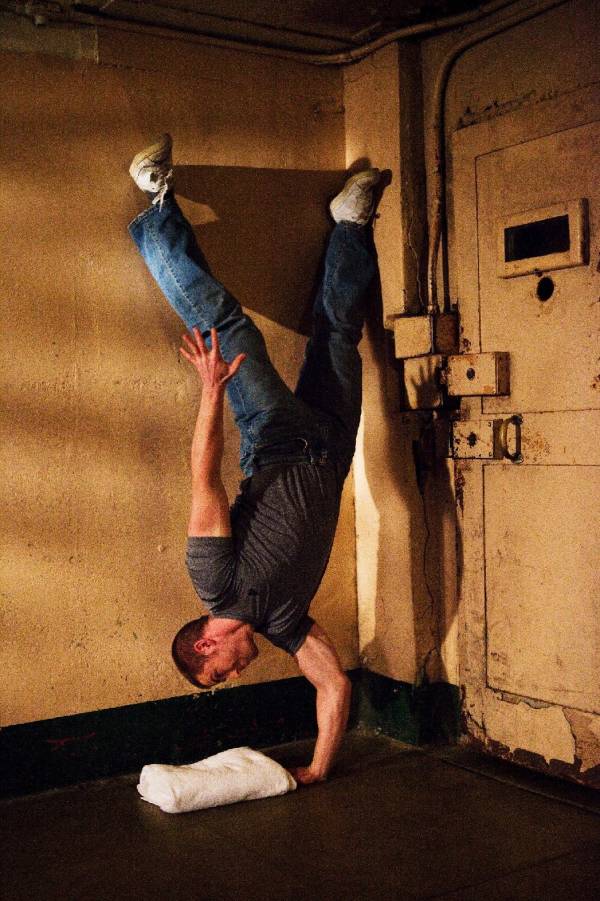EDITOR’S NOTE: Paul Wade is not your typical coach. We learned this because of, not inspite of, not being able to interview him or get any photographs. As you read in last week’s book excerpt, Paul Wade learned his trade over the course of twenty-three years in the penal system – hence the name of his series, Convict Conditioning.
In this week’s book excerpt Paul talks about the merits of bodyweight training and how it has disappeared from mainstream fitness:
The Forgotten Art of Bodyweight Training
Walk into virtually any gym in the world and you will find any number of pumped up steroid users who think that they are “strong” men because they have eighteen-inch arms, can bench press a heavy bar, or look big in a tank top or T-shirt.
But how many of them are truly powerful?
- How many of them have genuine athletic strength they can use?
- How many of them could drop and give you twenty perfect one-arm pushups?
- How many of them have spines that are strong enough, flexible enough and healthy enough that they can bend over backwards and touch the floor?
- How many have the pure knee and hip power to squat right down to the ground and stand up again – on one leg?
- How many of them could grab hold of an overhead bar and execute a flawless one-arm pullup?
The answer is:
Almost none.
You will find almost no bodybuilder in any gym today who can perform these simple bodyweight feats. And yet the kind of bloated poser you see strutting the average gym floor is viewed by the media and the modern public as the epitome of strength and fitness.
The bodybuilder-type has become the accepted status quo of ultimate conditioning. This seems like total insanity to me. What does it matter how much weight you claim to be able to lift in a gym or on a special machine? How can somebody be considered to be “strong” if he can’t even move his own body around as nature intended?
Becoming Strong
The average gym junkie today is all about appearance, not ability. Flash, not function. These men may have big, artificially pumped up limbs, but all that the size is in the muscle tissue; their tendons and joints are weak. Ask most musclemen to do a deep one-leg squat – ass-to-floor-style – and his knee ligaments would probably snap in two. What strength most bodybuilders do have, they cannot use in a coordinated way; if you asked them to walk on their hands they’d fall flat on their faces.
I don’t know whether to laugh or cry when see the current generation of men duped into handing over a fortune in overpriced gym memberships and for weights and other exercise gadgets, all in the hope of becoming strong and powerful. I want to laugh because I admire the con trick for what it is – a perfect grift. The fitness industry has duped the whole world into thinking it can’t get by without all this equipment; equipment it then sells to the mark, or rents out at exorbitant prices (in the case of gym membership). I want to cry because it’s a tragedy; the average modern trainee – who is not on steroids – makes little gain in size from year to year, and even less progress in true athletic ability.

To become hugely powerful, you don’t need weights, cables, fancy machines, or any other crap that the industry or the informercials are brainwashing you into thinking you can’t do without. You can gain Herculean strength – genuine brawn and vitality – with no special equipment at all. But to unlock this power – the power of your own body – you need to know how. You need the right method, the art.
Such a method does in fact exist. It’s based on traditional, ancient forms of training, techniques which are as old as training itself. This method has evolved by trial-and-error over the centuries, and has proved its superior ability to transform flimsy men into steel-forged warriors time and time again. This method is progressive calisthenics – the art of using the human body to maximize its own development. Calisthenics today is seen as a method of aerobics, circuit training or muscle endurance. It isn’t taken seriously. But in the past – before the second half of twentieth century – all of the world’s strongest athletes earned the bulk of their power through performing calisthenics progressively – to become stronger and stronger, day by day, week by week, year after year.
The Forgotten Art of Bodyweight Training
Unfortunately you will not be able to learn this art in any gym in the world. It has become lost to the vast majority of athletes during the modern era – quite recently in fact. It has been mercilessly pushed out of the light of day by a childish fascination with the plethora of new training technologies that have sprung up over the last century or so; everything from plated barbells and dumbbells to cable machines and hundreds of other novelties. The knowledge of how to perform calisthenics properly has been choked, nearly strangled to death by the propaganda of fitness manufacturers who want to sell you your right to train your own body and mind.
 Because of this assault, the traditional arts of calisthenics have become degraded, relegated to high school fitness methods for children. “Calisthenics” currently involves pushups, pullups and squats; all fine exercises, but done for high repetitions which will build stamina though develop little in the way of strength. A real master of progressive calisthenics – “old school” calisthenics – also knows how to build maximum raw strength. Much more than the average trainee could possibly hope to develop with a barbell or a resistance machine. I’ve seen men trained in old school calisthenics who were powerful enough to break steel handcuffs, tear apart a chain-link fence, and punch a wall hard enough to take big chunks out of it, splitting the bricks in the process.
Because of this assault, the traditional arts of calisthenics have become degraded, relegated to high school fitness methods for children. “Calisthenics” currently involves pushups, pullups and squats; all fine exercises, but done for high repetitions which will build stamina though develop little in the way of strength. A real master of progressive calisthenics – “old school” calisthenics – also knows how to build maximum raw strength. Much more than the average trainee could possibly hope to develop with a barbell or a resistance machine. I’ve seen men trained in old school calisthenics who were powerful enough to break steel handcuffs, tear apart a chain-link fence, and punch a wall hard enough to take big chunks out of it, splitting the bricks in the process.
How would you like that kind of awesome bodily strength?
I can teach you how to develop it in the pages of this book, but you won’t get it from going to a gym or doing high-rep pushups. That kind of raw, animal ability to unleash your body’s own powers only comes from knowing how to do old school calisthenics.
Read other excerpts from Paul’s books:
How I Learned My Craft: Doing Time
Old School vs. New School Calisthenics
To follow Coach Wade’s three weeks of workouts here on Pulse Beat Fit follow this link:
Strength & Conditioning Workouts from Paul Wade
Convict Conditioning and Convict Conditioning 2 are available through Dragon Door.
The 16-Week Ultimate Bodyweight Challenge is available through Pulse Beat Fit Training.






